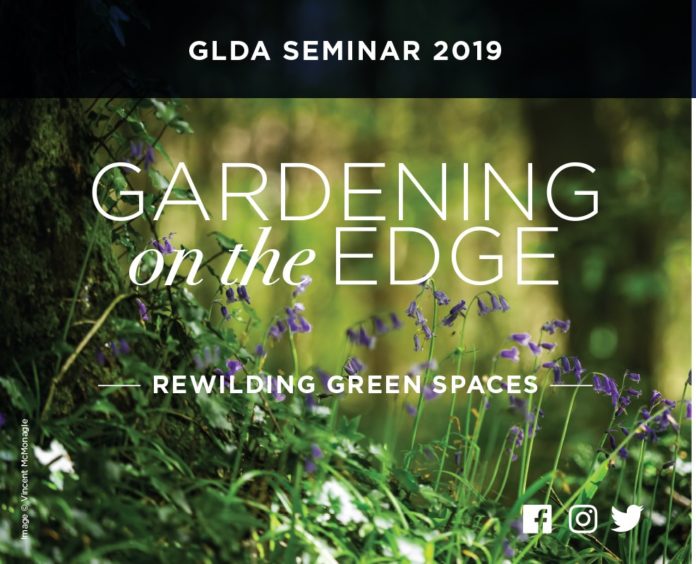With two-thirds of Ireland’s population now living in urban areas, the “rewilding” of open spaces has become imperative to push back against a damaging tide of concrete. The Garden & Landscape Designer’s Association (GLDA) annual seminar is to hear from a range of international experts about how gardens, by welcoming in nature, can play an extremely important role in helping to save the planet.
The Seminar – entitled “Gardening on the Edge – Rewilding Green Spaces” – will take place on Saturday 23rd February 2019 in the Crowne Plaza hotel in Santry, Dublin.
The timely gathering of some of Ireland’s most talented and best-known horticulture professionals – in association with Bloom by Bord Bia – comes against the worrying backdrop of stark World Wildlife Fund (WWF) statistics that show wild animal populations have plummeted by 60% in 44 years.
A diverse range of gardening, design and landscaping experts from around the globe will discuss the concept of rewilding. Speakers will include renowned French gardeners Thierry and Monique Dronet, British green roof expert Dusty Gedge, Texas-based landscape architect Kevin Sloan and Ennis-based wetlands professional Feidhlim Harty.
They will share their fascinating work in this area and the inspiration, thoughts and processes that underpin it. Attendees will hear how Irish gardeners and garden designers can help in the fight against habitat loss, extinctions, degradation, exploitation and climate change.
“In Ireland broadleaf woodland make up only 2% of our tree cover and species-rich grasslands have declined by 97%,” said one of the conference organisers Patricia Tyrrell. “With urbanisation comes less green space and more concrete. We are living on the edge. It has become impossible to ignore and it means we are also gardening on the edge. Is there something more we could do on an individual level, and as communities, to turn the tide and restore lost habitats for our dwindling populations of animals, birds and insects?”
The conference will hear about the growing philosophy of rewilding, which promotes a return to as close a version of wildness as can be achieved, where people share their space with the natural world of animals, birds, and insects rather than fighting nature.
“This involves creating a multifunctional landscape where everybody benefits. Most of our world’s landscapes have been altered by humans and their activities. Realistically we cannot completely reinstate the natural landscapes that were there before. But we can question our choices,” said Tyrrell.
The GLDA conference will tackle a series of tough and pertinent questions: Do we really need a concrete driveway or a pristine mown lawn? Could we have rich grassland on our roofs where birds might find refuge? Could we plant more native trees and plants in our gardens?
“In our urban jungles, we have to examine whether we could have woodlands, scrub or meadows instead of green spaces. We must look at giving back floodplains to our rivers with their valuable wetland habitats rather than encasing them in concrete. In the process we can begin to reconnect with nature, our best teacher,” concluded Tyrrell.
SPEAKER BIOGRAPHIES
Thierry and Monique Dronet of Le Jardin de Berchigranges
Mountains were literally moved to make the Dronet’s gem of a garden in Eastern France. Once described by Noel Kingsbury as the most beautiful garden he had ever been to, the garden at Berchigranges is the result of the collaboration between two plant enthusiasts, Thierry and Monique Dronet, who are constantly observing and learning from nature.
The pair will address the conference on ‘Acrobatic gardening at Berchigranges: how to keep balance while sharing control with nature.’
Both see gardens as a form of artistic expression, and together, they manage their botanical world like a theatre stage, where wild plants and species perennials are given the lead role.
Located in the Vosges mountains at an altitude of 700 metres, this remarkable garden, hewn out of rock and forest, stretches the limits of landscape design. Thierry Dronet, best described as a landscape architect, gave new life to the site – a former quarry and spruce plantation – creating a great variety of habitats by moving rocks, clearing stands of conifers and diverting streams and bringing in 2,000 tonnes of soil to allow a collection of 4,000 different plants to grow. Joined in 1994 by Monique, a local plantswoman whose nursery ‘A Cottage Garden’ promoted old cultivars and wild plants alike, they have created a planting style of their own. Never afraid to experiment – constructing one of the first green roofs in France, as well as a sloping labyrinth reminiscent of a pinball machine – they planted cultivated plants straight into an overgrown wasteland left by the spruce grower and dedicated a whole area to garden outcasts such as mosses and lichens.
The garden continues to expand with newer, wilder areas which they see as the future of gardens, offering the public an opportunity to experience nature close-up in a calm and restful space. Recently featured in Claire Takacs’ book ‘Dreamscapes: Inspiration and beauty in gardens near and far’, this talented duo has created what they call an ‘Ode to Nature’ which demonstrates their passion for plants, nature and the art of Landscape design.
Green roof expert and urban ecologist Dusty Gedge has been instrumental in the promotion and implementation of green infrastructure in the UK. Most cities are 80% roofscapes which give the massive potential for green roofs. Dusty believes all private and public buildings should have green roofs. Buildings usurp the natural environment and green roofs are a way to give back space to nature, improve air quality, provide important refuges for wildlife, improve the quality of life for urban residents and are vital to help our cities combat and adapt to climate change.
Actively involved as a child in the Kent Ornithological society, Dusty came to his current role via a circuitous route, or rather a circus route. He is a trained theatre performer who previously led a precarious life as a street entertainer and circus performer.
Dusty is the co-founder and driving force behind livingroofs.org, the number one website on green roofs in the UK and has campaigned successfully for a distinct living roof policy in London. Livingroofs.org has also been active in working with other cities in the UK such as Manchester, Bristol and Birmingham. He has co- written an online guide to building a small scale green roof (available at greenrooftraining.com) and is currently the president of the European Federation of Green Roof Associations. He has designed a number of seminal green roofs in the UK including Barclays HQ Canary Wharf, Grays Inn Road, London, and Komodo Dragon House at London Zoo.
Dusty works as a lead consultant with the Green Roof Consultancy and has provided specifications and designs for over 100 projects and as well as providing training for the construction industry and a number of local authorities.
Kevin Sloan is a landscape architect, urban planner and writer with international scope, located in Dallas, Texas. He is the founder and director of Kevin Sloan Studio, a design studio principally concerned with the urban design and landscape architectural problems generated by the metropolitan city and its new and unprecedented formation. He has taught architecture, urban design and landscape architecture at a number of universities and colleges, including as a visiting professor at Syracuse University in Florence, Italy. He has contributed numerous journal articles and is a former columnist on architecture and design for Dallas Downtown Business News.
Sloan’s built works encompass new prototypes, landscape systems and environmental strategies that address the ecology of the American Southwest and its similarities with North Africa – which share the same latitude. Works generally fall within the category of “landscape urbanism.” By transforming a typical street into a “biofiltration machine,” at Urban Reserve Dallas he won international recognition from Eco-Structure magazine as one of seven notable environmental projects in 2009.
Most recently, Sloan has authored and championed the idea of the “DFW Branch Waters Network,” an idea to organise the sprawling Dallas/Fort Worth metroplex around the area’s underlying network of the Trinity Watershed. This would allow many existing neighborhoods to develop local parks, allowing a “rewilding” of urban areas in select sections, and give new life to areas where new development could thrive.
Féidhlim Harty Wetland Systems (FHWS) was established in 1996 by the Cork native to provide a design, consultancy and planting service for constructed wetlands and to increase public awareness of constructed wetlands, wetland habitats and water quality. Modelled on natural wetland systems, constructed wetlands are purpose built for the treatment of wastewater using a selection of plants and a specially designed substrate.
Growing up Feidhlim could hear the sound of the waves of Cork Harbour from his bedroom window. He spent his youth canoeing and windsurfing and he witnessed water pollution first hand. He set out to educate himself on how to improve water quality using innovative alternative systems.
Now based in Ennis, Co. Clare, Feidhlim has since expanded his business to include other services to meet the growing awareness of environmental sustainability. Harty believes that innovation presents us with the opportunity to develop a new aesthetic that is wholesome as well as beautiful, to “grasp the nettle” and help reverse climate change, thereby protecting our most crucial resource, for people and wildlife.
Now nearly twenty years in business, FHWS continues to offer a professional yet personal service to homeowners, developers, industry and councils around the country. Past projects include construction and planting of the treatment wetland at Ballymaloe House, Co. Cork and projects with County Councils to construct wetlands and reed beds for cost effective, robust and reliable sewage treatment. He also carried out the planting of the domestic scale wastewater treatment wetland for an eco-house in Oranmore, Co. Galway, shown on the Our House television series with Duncan Stewart.
- Full Members & Pre-Registered Members of the GLDA …………€85.00
- Friends €85.00
- Students …………€55.00
- Non-Members (Early Bird €100) …………€110.00
BOOKINGS: www.glda.ie or info@glda.ie Tel: 353 (0)1 294 0092
ABOUT THE GLDA
The GLDA has been synonymous with professional garden design for over 20 years. The association represents some of Ireland’s leading garden and landscape designers, and its growing membership provides a wide range of services nationwide. It actively promotes its objectives through its journal, workshops, events, and annual seminar.











